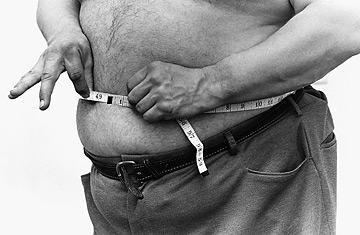
It's not every day that scientists uncover an unexpected new role for an old, familiar body part. That's why a paper published in the current issue of Cell is generating so much buzz. A team led by Dr. Gerard Karsenty, chairman of the department of genetics and development at Columbia University Medical Center, found that the skeleton plays a powerful role in the regulation of blood sugar and fat deposits. The discovery, made through an elegant series of experiments in mice, could have important implications for treating and preventing type 2 diabetes and obesity — two conditions that are exploding around the globe.
One tends to think of the bones as inert, calcified structures, but they are, in fact, active tissues that constantly renew themselves. Cells called osteoblasts continually build new bone, while osteoclasts destroy old bone. What the new research shows is that the bones also act as a kind of endocrine organ. They release a hormone called osteocalcin that not only acts locally to influence bone formation, but also increases the production of insulin in the pancreas, raises the body's sensitivity to insulin and reduces stores of fat.
No one had any idea it played this role, says Dr. Saul Malozowski, a senior endocrinologist at the National Institute of Diabetes and Digestive and Kidney Disorders. "The skeleton used to be thought of as just a structural support system. This opens the door to a new way of seeing the bones." The finding parallels discoveries in the 1990s about the metabolic activities of fat — another body tissue that was once seen as inert.
Karsenty became intrigued by the relationship between fat and bone after showing in 2002 how leptin, a hormone secreted by fat cells, influences bone formation. Leptin is best known as a regulator of body weight and appetite. Karsenty reasoned that if fat influences bone, then the reverse must be true. And, he says, there was another clue to the relationship: "We were using the observation that obese people are [relatively] protected from osteoporosis."
In some ways it's logical that bone and fat tissue would talk to each other. "Obviously there does need to be some coordination between skeletal growth and body mass," says C. Ronald Kahn, director of the Joslin Diabetes Center at Harvard. "If you carry around extra weight, your bones need to hold up under the extra pressure, so it's not surprising that your bones have a sense of body fat."
But no one suspected just how powerful a role the bones play in so fundamental an activity as regulating sugar. Over a period of three years, Karsenty's team conducted a series of experiments with eight strains of mice, including some genetically altered to lack osteocalcin and some engineered to overeat. He found that osteocalcin significantly impacts how the body handles glucose, its primary fuel, in three ways: by raising the number of insulin-producing beta cells in the pancreas, by directly boosting the output of those cells, and by raising the body's sensitivity to insulin.
Finding a substance that increases beta cells, says Karsenty, "is a holy grail for diabetes research. If what's true for mice proves true for humans, "then we have inside us a hormone that does precisely this." In mice that are programmed to overeat and mice that are fed fatty diets, high levels of osteocalcin prevented both obesity and diabetes. Karsenty is now examining whether giving diabetic mice osteocalcin will reverse the disease.
Exactly what this means for people remains to be seen. Researchers have known that people with diabetes tend to have low levels of osteocalcin, but until now no one understood the significance. "This will open up a lot of new avenues for investigation," says Kahn.
